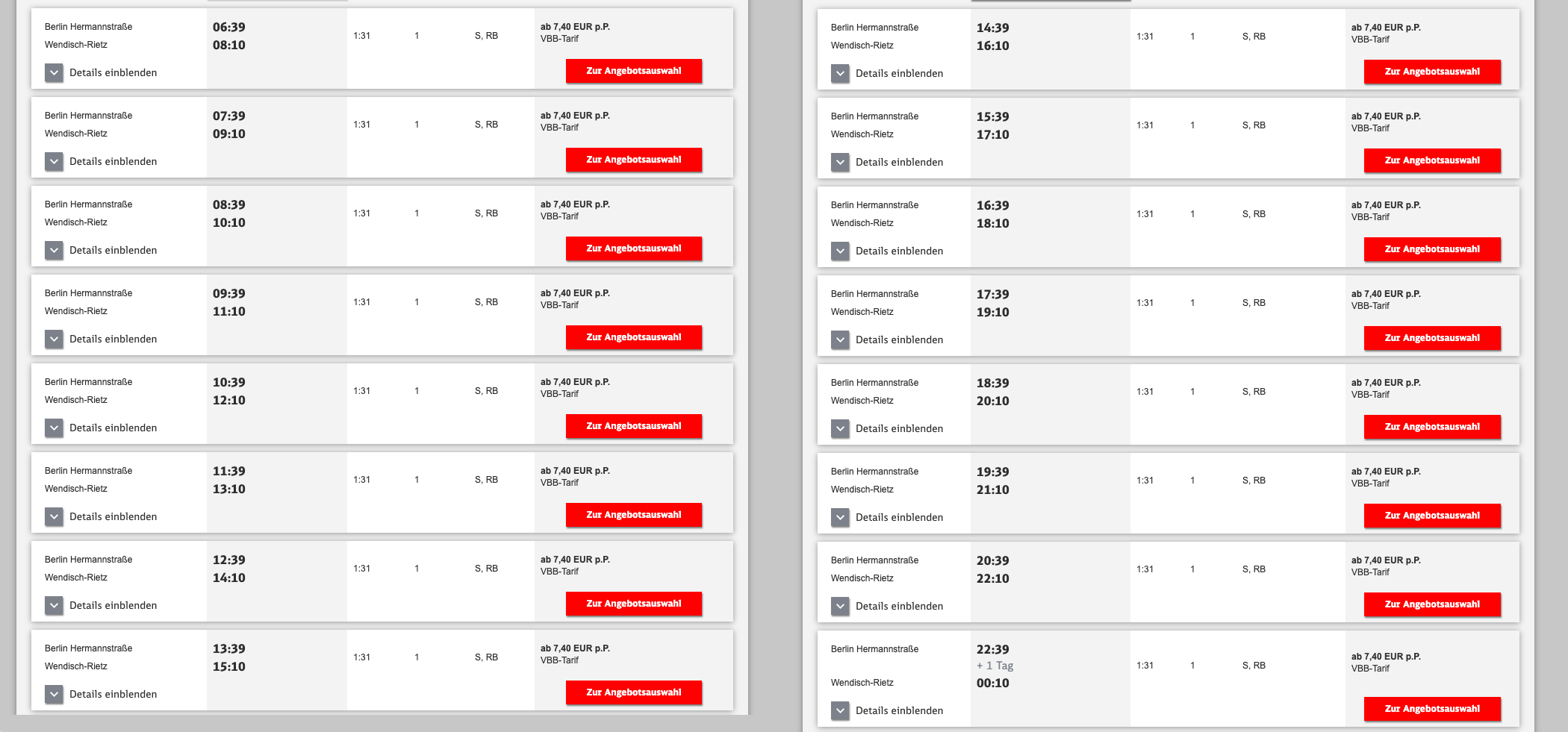One of my lockdown pastimes has been to explore Brandenburg, the Land that surrounds Berlin. One such trip took me to the village of Wendisch Rietz (population: 1620), south east of Berlin, and at the southern end of the lake Scharmützelsee – to walk along the edge of the lake was the reason for my trip.
Wendisch Rietz is served by the RB36 Königs Wusterhausen – Storkow (Mark) – Beeskow – Frankfurt (Oder) train route, operated by Niederbarnimer Eisenbahn, within the Verkehrsverbund Berlin Brandenburg. At the moment the line is operated with Stadler Regio-Shuttle RS1 single carriage diesel trains, that are due to be replaced with battery-electric trains from 2024.
Here is the timetable to get there, from my nearest station on the Berlin S-Bahn, Hermannstrasse. It involves taking the S-Bahn to Königs Wusterhausen, and then the RB36 from there (click to enlarge):
There is a train every hour all day long, with just 1 hour missing – between 2039 and 2239. This means that pretty much whatever it would be that I would want to do, the maximum amount of time it will take me for the next train to come along is an hour. Regular commuter trip? Indeed. Work meeting in the middle of the morning? Sure. Lunch? No problem! Dinner and a beer in Berlin? That works as well. And oh hell, something has changed, I need to change my plans – no problem!
This is what the Germans call a Taktfahrplan – a clock face timetable in English – where the trains run at set intervals the whole day long.
And this is so much better than a bus. A Regio-Shuttle can transport 8 bicycles – that’s hard in a bus. There’s a fully accessible toilet – find one of those in a bus! And because it’s a train rather than a bus it’s not going to get stuck in traffic and delayed.
Above all it allows me (someone in Berlin wanting to go to Wendisch Rietz), or someone in Wendisch Rietz wanting to go to Berlin, a completely flexible means of transport that can manage to cope with whatever my needs are, and pretty much however they might change. And if I want to bring a bike with me, or I am a person of reduced mobility, that works as well.
Compare that to a route I want to try to take in France later this summer – between Belfort (population: 46954) and Vesoul (population: 14973). Dates are different as lines are closed for engineering works in the summer, but here’s the regular timetable (click to enlarge):
This is basically all adapted for school and college pupils – to get them to their classes in the morning, and back in the evening, and that is pretty much it. There is a gap of almost 6 hours in the middle of the day, and the last train goes at 18:39 – meaning doing pretty much anything after a work day is going to be impossible here. Dinner in Belfort before returning home? Forget it. Suddenly need to make a trip at lunchtime? No way. That means – most importantly – that a person cannot rely on the train here. No one can integrate it into their everyday life the way I can with the Wendisch Rietz train. And this between two reasonably important regional centres in eastern France!
OK, you may say, I am not comparing like with like. Correct. The population structures and level of urbanism are different. But the problem is the same one: if you want people to abandon their cars, you have to provide a round the clock rail service on regional lines that means the train can match their mobility needs, instead of the person adjusting their needs according to the train timetable. The only flexible way to travel between Vesoul and Belfort is with a car, and that simply is not good enough – when the rail lines exist, but an adequate service does not!



If you want a comparable route for Belfort-Vesoul, I am sure there are countless in the DACH-Region, but one I would highlight is Villach (pop ~63000) to Hermagor (pop ~7000). Since last timetable change, there are daily and hourly trains until 21 o’clock with one extra at 23 and night service running until 1 on weekends in the summer months. All services provided with 3-part EMUs.